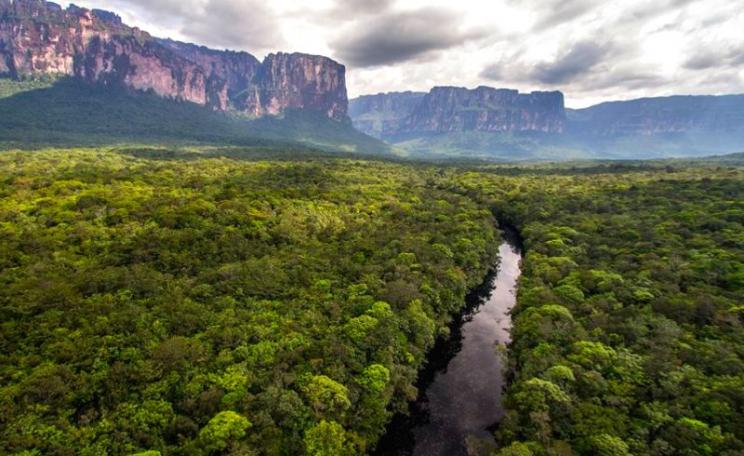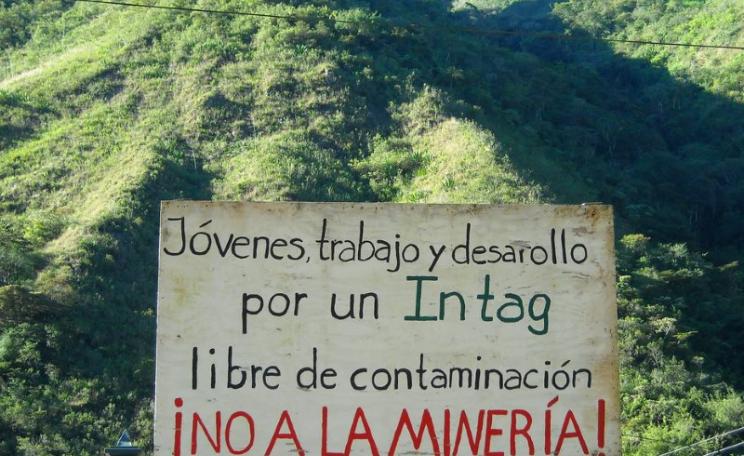We've seen the negative impact in other places where there are mines ... and this area is precisely between the winter and summer pastures, a railway for the mine will cut off the migration routes.
A dirt road leads deep into thick forest of pine and spruce some 25 miles west of the small town of Jokkmokk in Sweden's far north. Beard lichen - an indicator of the pure air quality - hangs thickly from the branches.
Taking a left at a road sign for Kallak, the sound of heavy machinery cuts through the ranks of conifer as workers drill into the bedrock rich in iron ore. Close by, an encampment of protestors block the road leading to the site.
The proposed Kallak mine is pitting environmental activists and the region's indigenous population - the Sami, who number around 20,000 in Sweden - against those in favour of mining as a means of boosting jobs and revenue.
New Era of Exploitation
With projected long-term global demand for iron ore, Sweden's Arctic north - a 'resource Eldorado' that for decades has provided the majority of the country's hydropower and is already the site of Europe's largest iron and copper mine - is once again seen as ripe for further development.
"This is the starting-point of a worrying new era of exploitation", says Sara Lahtinen, an opponent of the mine and cultural historian, pointing to Sweden's new mineral strategy released in June 2013 that aims to make Sweden the EU's leading mineral country; it already accounts for 92% of European iron production.
With Swedish Prime Minister Fredrik Reinfeldt having announced that mining is to Sweden what oil is to Norway, the Swedish government hopes to increase the number of active mines from 16 to 47 by 2030 - most in the north of the country.
Iron production could more than double
It is forecast that such an expansion would boost iron production from a yearly 68 million tonnes to 150 million tonnes.
Keen to cash in is the British-based mineral exploration company Beowulf Mining, which, through its Swedish subsidiary Jokkmokk Iron Mines AB, has a two-year test permit (subject to extension) to explore two adjacent iron ore deposits, Kallak North and South.
Test drilling and sampling is currently underway in an area noted as an Area of National Interest by the Swedish Geological Survey in February last year, and possible iron ore resource estimates have been put at 600 million tonnes.
Production is forecast to commence in 2018 at the earliest.
Lifeline or death knell?
With a population in long-term decline and a dearth of employment opportunities, mining is seen by its proponents to be a lifeline to Sweden's northern inland communities such as Jokkmokk.
Its population has declined by nearly 25% in just two decades as people move to larger coastal towns and Stockholm in search of jobs.
Local and regional politicians therefore look expectantly upon the projected 350-400 full-time jobs that the mine will create whilst supporting many more in the restaurant, hotel, and transport sectors.
We've seen the negative impact in other places where there are mines ... and this area is precisely between the winter and summer pastures, a railway for the mine will cut off the migration routes.
Not everyone is convinced that the mine will bring the expected benefits, however. "There will be no guarantee whatsoever that the region will gain anything from the mine", fears local teacher Björn Nordkvist.
Jokkmokk's municipal chief executive, Anders Nygårds, remains coy about the development. On the question of jobs and revenue, however, he admits that no-one is 100% sure:
"That is the big, big challenge. We need to fix a lot of things so that it will not be a fly-in fly-out situation. Houses need to be built so that people can move here and pay taxes ... if all of the mine workers live in Stockholm the municipality will receive nothing."
Sami way of life under threat
While the debate over what the precise economic benefits will be is uncertain, the region's Sami population, who have herded their reindeer here for centuries, are adamant that the mine would endanger their livelihoods.
The mine sits atop an important spring grazing ground for the reindeer. Not only this but the mine would also need an upgraded road and rail infrastructure to get the iron to the ports of Luleå and Narvik.
"It could be devastating", says reindeer herder Jonas Vannar and vice-chairman of Sirges Sameby, one of the three Sami villages affected by the mine.
"In reindeer herding it is crucial for the reindeer to be able to migrate. We've seen the negative impact in other places where there are mines ... and this area [Kallak] is precisely between the winter and summer pastures, a railway for the mine will cut off the migration routes."
Reindeer herding is part of the economy
Keen to stress that reindeer herding is also an important part of the region's economy, he fears that the mine could affect the livelihoods of hundreds of Sami:
"The grazing pastures for the reindeer have already grown smaller ... it's hard to say when a point of no return is reached. But with this mine, I personally fear that it will affect my survival as a reindeer herder."
While the Sami have extensive rights to use the land for hunting, fishing, and herding, land ownership remains a contentious issue.
Sweden has also not ratified Convention 169 of the International Labour Organization, which, if properly implemented, would give the Sami a greater say over how the land is used.
Threat to World Heritage Site
Further adding fuel to the debate is the fact that the mine is located less than 50 miles away from Laponia World Heritage Site, selected by UNESCO for its outstanding natural beauty as well as cultural importance for the Sami.
One of the main roads to the Laponia area passes close by the proposed mine.
"The two just do not fit", says Björn Nordkvist, arguing that the promotion of nature tourism, also important to Jokkmokk's economy, and mining is incompatible. "What tourist wants to see 90 tonne trucks passing every few minutes?"
Even though the Kallak mine is not in Laponia, reindeer herders point out that is precisely where their summer pastures are located - and if the mine goes ahead, they may no longer be able to reach them.
"If access to and from our summer pastures is impeded because of this mine, that undermines the cultural basis on which Laponia was chosen as a World Heritage Site", says Jonas Vannar.
More exploration permits
Other exploration permits for mining exist throughout the municipality. "Definitely, if there's one open pit mine, there could be another two, three, four, five mines", admits Anders Nygårds.
And while environmental regulations are strict in a region dominated by a patchwork of national parks and nature reserves, a study commissioned by Beowulf Mining notes that exemptions could apply if deemed in the 'public interest'.
The company has been keen to proclaim its environmental credentials, but opponents like campaigner Risto Koskinen view so-called clean mining as impossible:
"How is the waste going to be stored, how do you transport the stuff? You will always have leakages. You can never say something is 100% safe. They have already done stuff that is illegal."
A lack of trust exists, with Beowulf Mining having been forced to apologize in 2012 after two Sami villages reported the company for having carried out drilling without having all the necessary paperwork.
Looking nervously to the future
With explosives laying bare the iron-ore rich deposits, initial results from test sampling have been described as "encouraging" by Beowulf Mining, which hopes to apply for a 25-year exploitation concession.
Complex negotiations involving a large number of stakeholders - not least the regional county board and the Mining Inspectorate of Sweden - lie ahead if the Kallak mine is to become operational.
Jonas Vannar looks nervously to the future: "We've had no problems here for decades between the various groups and we want to keep it that way. But the mine has created a conflict between Sami and non-Sami and legitimized a more hostile attitude towards us."
With mining being pushed forward by the government as key to Sweden's economic future, it has ushered in a new era - one that could define and divide Sweden's far north for decades to come.
Alec Forss is a freelance writer living in Sweden. See his website at www.alecforss.com.





